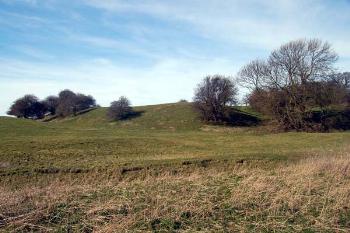
Cainhoe Castle
Domesday Book was commissioned by William the Conqueror (1066-1087) at Christmas 1085. It was designed to show who held every piece of land in the newly conquered Kingdom of England. It was known colloquially as the Domesday Book because it was seen as being as final as the Last Judgement and as difficult to conceal things from. The book does not cover the whole country - Cumberland, Durham, Northumberland, and Westmorland were omitted and London and Winchester likewise, along with some other towns. A separate book, called Little Domesday covered the counties of Essex, Norfolk and Suffolk and, despite its name, it is actually bigger and more detailed than the Great Domesday Book containing the other counties.
In 1086 there were two manors of Cainhoe. The smaller one was held by Azelina, wife of Ralph Tallboys and her tenant was called Thurstan. The manor was just one hide and had one villager and three smallholders. These three were the heads of household and so, with their wives and children made a population of between ten and twenty. There was woodland for a hundred pigs. The manor had been owned by Wulfric, a freeman of King Edward the Confessor and had been worth twenty shillings in 1066, the same as in 1086 but when Azelina acquired it the manor had been worth only ten shillings.
It is suggested by historians that the reason for the general lowering of the value of manors in the area is accounted for by William I's armies coming through Bedfordshire on their way to put down rebellions in the north. They would have lived off the land and no doubt have committed certain acts of vandalism in what was, to them, still alien, even enemy, territory.
The larger manor was held by Nigel de Albini without a tenant. His manor extended over four hides and had three villagers, three smallholders and five slaves - a total of around fifty including wives and children.
The mention of a mill and the reasonable size of the population, for the day, might possibly suggest that this manor included land now in the village of Clophill itself. The mill did not, of course, necessarily stand on or near the site of today's Clophill Mill but it might not have been far away. Alternatively the mill may have stood near the castle. The site of the old Clophill church on the ridge suggests that the medieval village of Clophill might have mostly lain around rather than below it, as it does today and so perhaps most of the flatter land might then have been regarded as part of Cainhoe.
Before the Norman Conquest Cainhoe had been held by Ælfric, a thegn of King Edward the Confessor and had then been valued at 100 shillings. By the time Nigel acquired the manor it was worth just 30 shillings, though this had risen to 60 shillings by 1086.